Fishing Jig Streamers on Mono rigs
A highly effective technique for New Zealand Trout
Fishing a jig streamer on a mono rig is a deadly technique for New Zealand trout - and also a lot of fun.
The combination of jig streamer and mono rig allows an angler to reach fish and also achieve presentations not possible with a regular fly line.
I’m not talking about lobbing jig streamers using euro techniques, but modified traditional overhead fly casting to achieve surprising distances.
Advantages of streamers on mono rigs
Some advantages of using the mono rig and jig streamer in comparison to fishing streamers on Spey gear or a regular fly line, are:
1. |
There’s little chance of lining fish.
|
|
2. |
There’s no fly line or tapered leader to impede the rise and dive action that effectively imitates bottom-dwelling baitfish, like bullies, sculpin and torrent fish.
|
|
3. |
Mono is less affected by currents than fly lines, allowing far more control of the flies and greater sensitivity. There’s also less line sag when high-sticking.
|
|
4. |
You won't need to change lines or tips to control the depth, simply change the weight of the fly and the presentation (more on that later).
|
|
5. |
Ability to fish a jig streamer with a 4.5 or 5.5 mm tungsten bead on a 4 or 5wt rod.
|
|
6. |
Being more sensitive than fly lines the hits on stripped and swung streamers on mono rigs are about as solid as they get. |
What is a Mono Rig
A mono rig is basically a length of monofilament that replaces a traditional fly line.
A stiff monofilament that has little memory once stretched is essential, which is why Maxima Chameleon (not Ultragreen) is so popular.
Some anglers use very thin mono - down to 6 or 8 lb Chameleon - and heavy streamers, so they can lob them, much like casting with a spinning rod.
Using a heavier stiff mono enables one to cast streamers with modified overhead fly-casting techniques, which I prefer. These casts rely on the pull of the streamer and push from the line. With two or three false casts, distances of 55 ft are easily achievable.
A further advantage of thicker mono is that it’s far easier to grip when stripping and easier to handle loose line when a good fish strikes toward the end of a long retrieve and then takes off.
Thicker mono is also easily mended to control the drift and allow flies to sink to the required depth before swinging or stripping.
Mono Rig Options
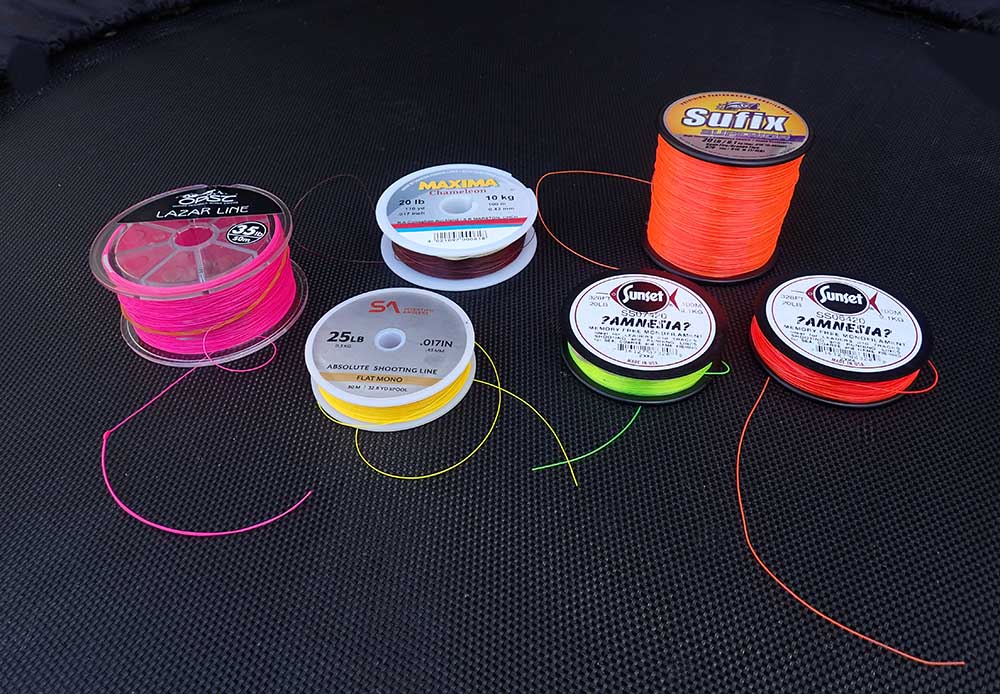 |
I have experimented extensively over the last two years with mono rigs made from five different main lines:
1) 35 lb OPST Lazar line
2) 25 lb Scientific Anglers Flat Mono shooting line
3) 20 lb Maxima Chameleon
4) 20 lb Sufix Superior Neon Fire and
5) 20 lb Sunset Amnesia in both red and neon green
I’ll go through these mono options in the order I tested them.
OPST Lazar and SA Flat Mono Shooting lines
I started with these two shooting lines because I was already using them for single hand Spey outfits.
Leaders for the two shooting lines consisted of around 1.5 ft each of 20 lb and 15 lb Maxima Ultragreen blood knotted together.
At the butt end of the 20 lb Maxima Ultragreen was a small Surgeons Loop, which was looped onto the loop in the shooting line, and at the end of the 15 lb Maxima was a large tippet ring to which I attached 5-6ft of 3X SA Trout Fluorocarbon tippet.
The shooting lines worked better than expected but didn’t cast as far as other systems I tested.
When it comes to these shooting lines, I favour the 25 lb SA Flat Mono because it shoots further with the light Skagit and Scandi heads I use on my jig streamer rods. The rods I regularly use for jig streamers are also great for single hand Spey.
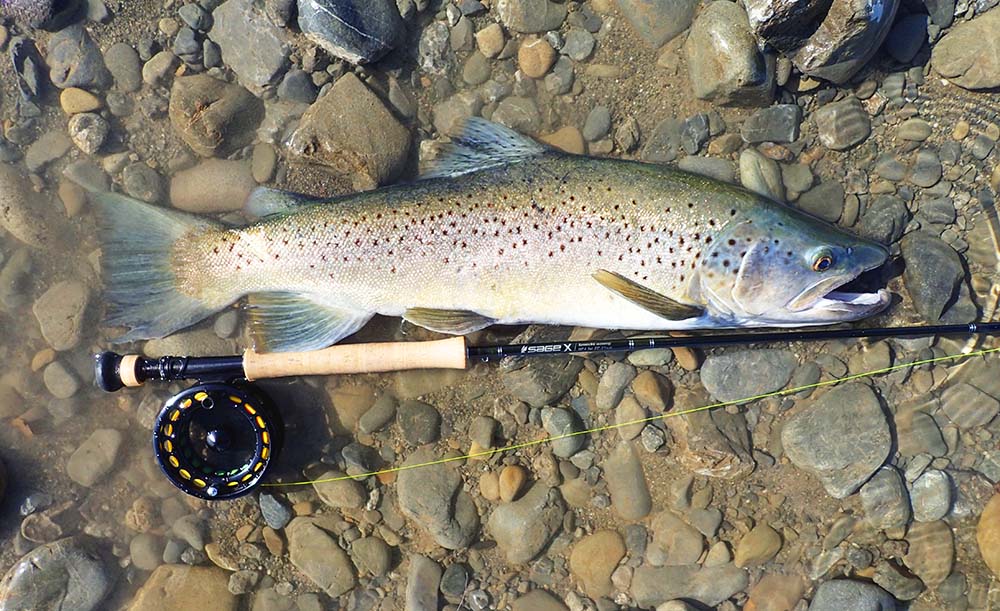 |
One of the first fish I caught on a jig streamer and mono rig. I was using a 9.5 ft Sage X 5wt and a SA Flat mono running line with 4.5 mm tungsten bead streamer
The Maxima Chameleon system
I chose Maxima Chameleon because it seems to be the most popular, on account of its stiffness and low memory, for butt sections on heavy euro leaders, including those for streamers.
My Maxima Chameleon system consisted of 50 - 60 ft of 20 lb Maxima Chameleon to which I attached 3 ft of 14 lb Maxima High Visibility yellow, with tippet ring on the end.
I tried using 12 lb Chameleon instead of the HV, but the Chameleon is brown and hard to see, so it’s difficult to track the fly or detect takes on upstream casts when jigging euro style. The HV is not so bright and opaque that it spooks fish.
For added visibility, I attached a backing barrel made from orange 20 lb Scientific Anglers Dacron backing to the section of Maxima HV (see photo below). A hack from the Troutbitten website that proved very effective.
When euro nymphing or jigging streamers euro style, I slide the backing barrel down to the tippet ring to improve strike detection.
When casting and stripping streamers, I slide the backing barrel back to the knot with the Chameleon to increase distance between the backing barrel and the fly, so I can more easily track the drift when the sighter is on or under the water.
The sighter helps locate the streamer when swinging or retrieving, and also lets me know when to pick up and cast.
The SA 20 lb Dacron is bright, the weave is tight and doesn’t fade or fray over time, as long as you singe the tip with a flame. I highly recommend it for the backing barrel.
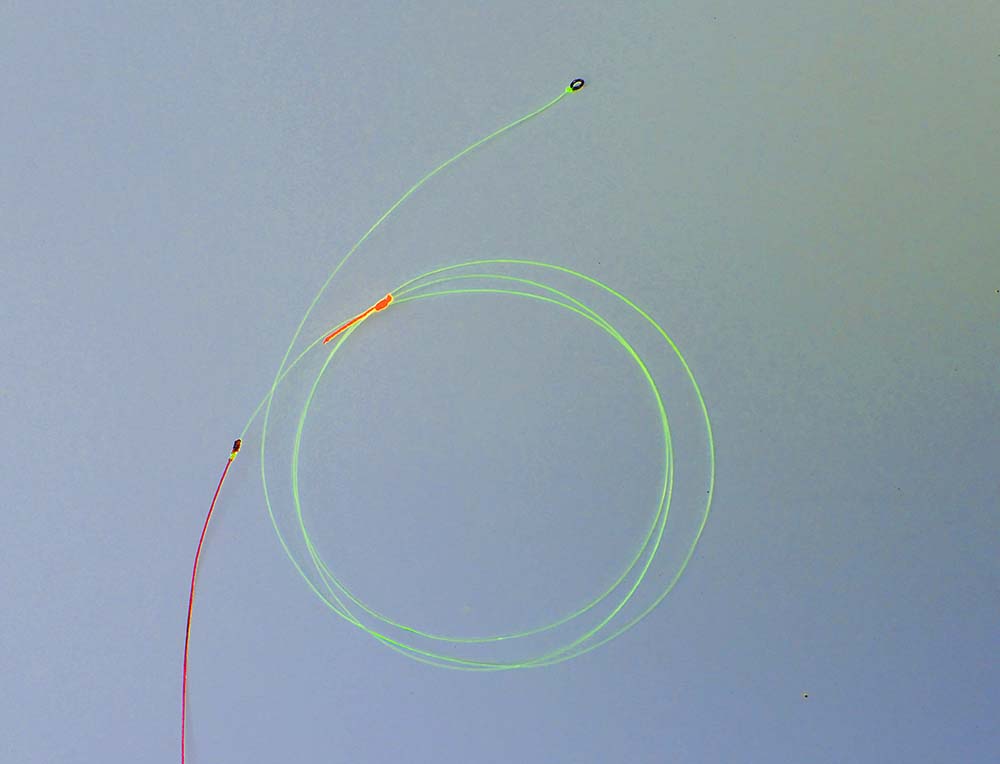 |
Backing barrel on the HV Maxima section of the Chameleon mono rig
The Chameleon system casts further than all the other systems I tested, but is a little harder to grip when stripping and harder to see on the water. That said, once used to the thinner line and subtle sighter, the pros certainly outweigh the cons in many fishing situations.
If I only fish jig streamers, or I’m alternating between jig streamers and euro nymphing, then the 20 lb Chameleon system is the go to.
To nymph, I simply remove the 3X tippet and attach a rig (stored on a foam spool) consisting of 1.5 ft of 0-1X tri-colour indicator, a small tippet ring, and 4-5X tippet.
The bright tricolour indicator is made soft to detect strikes when nymphing, but is not good at turning over jig streamers at a distance. And as it’s under the water when stripping streamers, the indicator is likely to spook some fish, or at least distract them from the streamer. So I remove the tricolour indicator when fishing streamers.
The Sufix Superior
I tested the 20 lb Sufix Superior Neon Fire and Sunset Amnesia because I was looking for a line that was easier to see than Maxima Chameleon, but would cast further than the two shooting lines discussed at the beginning of this section.
The Sufix Superior was a Troutbitten recommendation (see link at the end of this article).
For both the Sufix Superior and Amnesia systems I used a step down of 2 ft of 20 lb Chameleon and 1.5 ft of 12 lb Chameleon, all blood knotted, to which the tippet ring was attached. Since the main lines are bright red or neon green, I didn’t need a sighter and also wanted to extend the distance between the bright main line and the fish.
Like all mono, the Neon Fire and Amnesia have some coil when they come off the reel, but this is removed with a very light stretch when the line is stripped from the reel under tension. Both lines are very slick and float and mend extremely well.
20 lb Sufix Superior Neon Fire is a little thicker than 20 lb Maxima Chameleon (0.45 mm vs 0.43) and is a lot easier to see. It is a little thinner than 35 lb Lazer Line (0.47mm), but noticeably stiffer when new.
The Neon Fire doesn’t cast quite as far as the Chameleon, but does cast further than the SA Flat mono and OPST Lazar lines.
On the downside the Neon Fire absorbs water and becomes a little softer and ‘crinkly’ after a couple of hours. Once this happens the line tends to tangle more often than the Chameleon, especially when casting more than 30 feet and dealing with significant amounts of loose line. Not a deal breaker, but something worth noting.
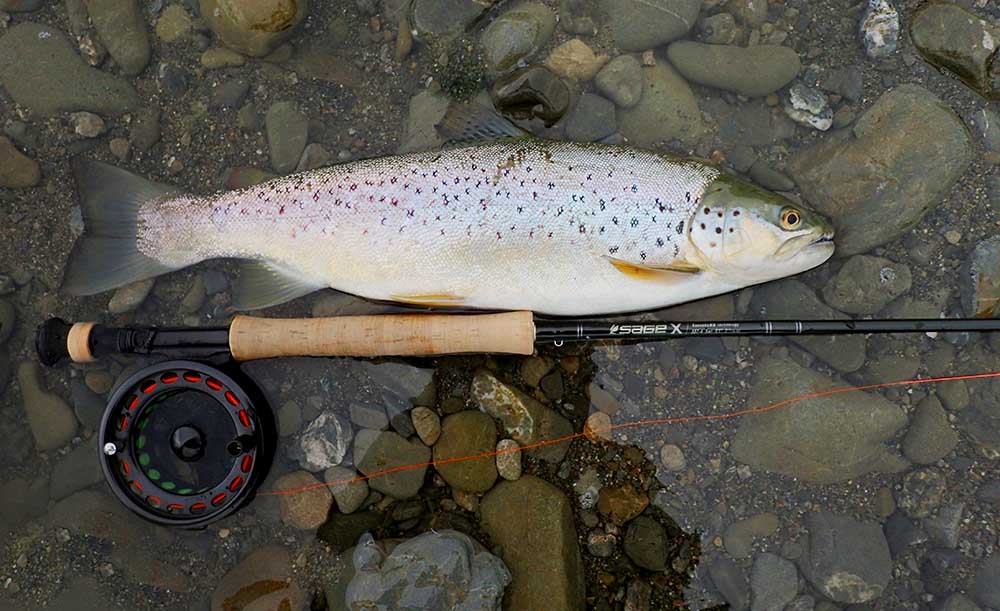 |
Sea trout on the Sufix Superior Neon fire mono rig
Sunset Amnesia
Sunset Amnesia has a very long history as a shooting line or mono leader, because it is stiff and has little memory.
Several fishing articles on the internet claim that Sunset Amnesia is oval in cross section. The Sunset Amnesia I have is not oval but round. So it seems Sunset make, or have made, round and oval versions, although not labelled as such.
My review here is for 20 lb round Amnesia in both red and neon green.
The 20 lb Amnesia is a little thicker and stiffer than the Sufix Superior (0.48 mm vs 0.45 mm) and the red is brighter in colour. The 20 lb Amnesia has the same diameter as 25 lb Maxima Chameleon and 35 lb Lazar line.
The Amnesia loses it’s coil quickly and is very easy to handle at water temperatures of 12 - 16 degrees Celsius - handling actually improves during the first half hour on the water.
However being thicker than the 20 lb Chameleon and the Sufix, it doesn’t cast quite as far with lighter jigs and presentation is not as good, as it makes a little more splash. It is also more affected by wind.
Although the 20 lb Amnesia has the same diameter as the 35 lb Lazar line, it is stiffer and slicker and for these reasons casts better with jig streamers.
I found the red Amnesia a little too bright as I felt it might spook fish in clear water. The green Amnesia, although easy to see, is more subtle than the red.
20 lb Amnesia would make a good mono rig for casting articulated streamers or larger jig streamers, eg 1/32 - 1/8 ounce jig heads.
15 lb Amnesia, with a dia of 0.41 mm, would possibly be a better choice for a standard Jig streamer mono rig, although I have yet to test it.
When high visibility lines work best
The Superior Neon Fire and Amnesia systems perform well on larger rivers when most casts are longer than 40 feet, especially on dull days when I use mono rigs most.
The high visibility of the brightly coloured main line makes it much easier to control the drift, manage loose line and track the path of the fly.
I especially like to use bright main lines when the water has some colour and the Chameleon is hard to track. When lying on the surface in discoloured water bright lines are also less visible to fish.
The 20 lb Neon Fire and Amnesia make good running lines for the light 150-200 grain head systems I use for spey casting on my 4wt and 5wt single hand rods.
I simply cut off the short Chameleon leader and tippet I use for jig streamers on these lines, and then tie the Neon Fire/Amnesia to a short double loop of 30 lb braid mono using a clinch knot, which is looped on to the butt of the shooting head (see photo below).
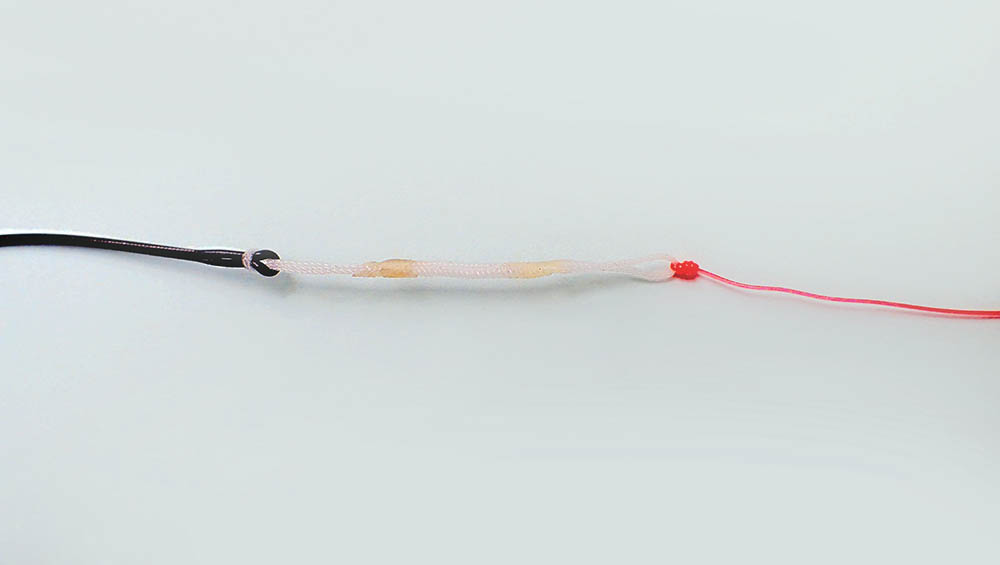 |
Attaching the Neon Fire to a SA Scandi Lite using the clinch-knot braid-loop connection
In addition to being quick and easy to change between mono rig and shooting line, this method creates a small knot and a very smooth connection that doesn’t cut into the rear loop on the shooting head.
Casting
Fly casting jig streamers on mono rigs does take some practice, but is very satisfying when one gets it right.
Apart from water-loaded casts, which I hardly use, jig streamers can be cast a surprising distance with standard overhead fly casting and a double haul. The trick is to wait to feel the tug on the back cast before making the forward delivery.
Without the weight of a fly line it’s not possible to change direction when overhead or water load casting, as the fly is always going to land 180 degrees from where it is on the back cast.
Enter the helicopter, oval or circle cast ...
The helicopter, circle or oval cast
By lifting the fly from the water with 1 to 1 ½ half rod lengths of line out of the top guide then swinging it out and about around your head, it’s possible to place the fly in any direction.
The trick to the circle cast is to keep contact with the fly throughout the overhead swing. The fly can be kept in the air or placed on the water in front of the angler before making the overhead casts in the direction of the target.
If the river is flowing from right to left, then the oval cast is made clock-wise.
If the river is flowing from left to right then it is made anti-clockwise.
Once the casting is mastered, mono rigs are amazingly accurate. One can consistently send the streamer under overhanging trees, to within inches of the bank. I often catch fish in spots I cannot fish effectively with a regular fly line or Spey gear.
When casting for distance, I mostly use one circle cast followed by one or two crisp false casts, the last with a double haul.
Distance
With a 9.5 ft 5wt or 10 ft 4wt rod I can easily cast forty-five feet with 4.5 mm and 5.5 mm tungsten bead streamers and SA Flat Mono or OPST Lazar line, and 55 ft with the 20 lb Chameleon rig. My initial Chameleon rig was 58 ft long, including tippet, and I frequently ran out of line. I now make my rigs with 60 ft of Chameleon.
Distance with the Sufix Superior is almost as good as with the Chameleon.
Achieving distance when wading deep in faster water is a bit more difficult due to the drag on the loose line created by the current. Managing line by coiling it in your hand, as you would a running line when Spey Casting, is helpful in this situation.
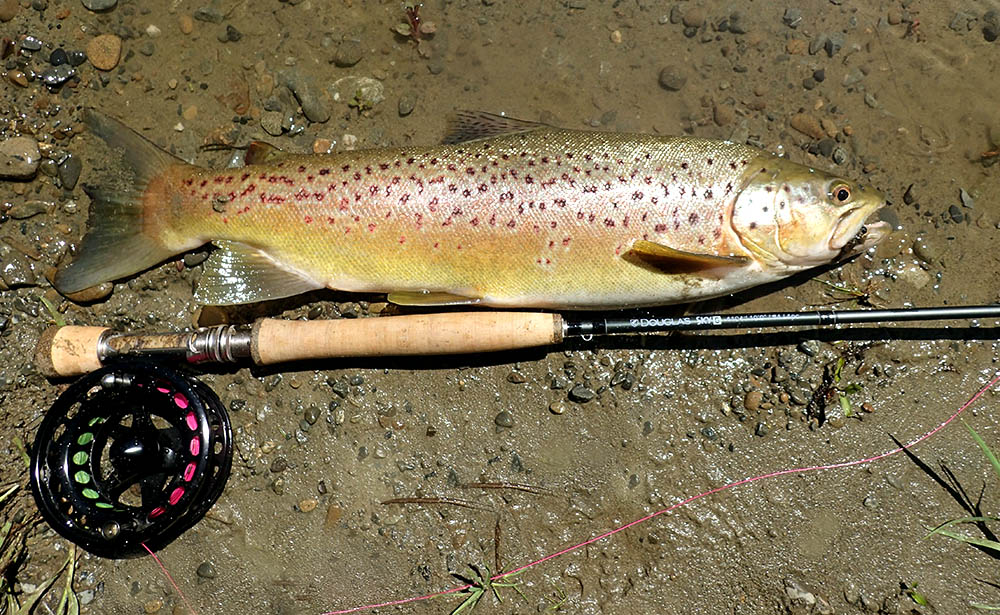 |
Fishing a jig streamer on 35 lb OPST lazer line
Fishing techniques
The euro method
The euro or tight line method was developed by anglers using nymphing rods, and most videos on the internet are about this approach.
With this method, the jig streamer is cast upstream on a relatively short line, then either led or gently jigged back downstream under tension, keeping it within inches of the bottom. The streamers are often allowed rise on the swing. With this technique the line and a sighter are kept off the water, except during the swing, and the sighter is used to detect subtle takes and gauge depth.
Stripping
While the euro method is highly effective in certain situations, I’ve caught many more fish on larger rivers when casting greater distances and using erratic strips and the rod tip to animate the jig streamers. This includes: casting upstream and stripping faster than the current, casting across or up and across or even across and down, depending on the water on hand.
It is easy to cast up-and-across above a section of promising water to allow the weighted streamer to sink to the required depth, by using mends or holding the line off the water, before stripping.
I find that thicker mono lines mend very well, especially with longer rods. A brightly coloured main line or a section of Maxima HV with backing barrel helps to track and position the drift. Because the jig streamers sink head first, like diving bait fish, strikes often come on the drop.
When stripping streamers, I use the following technique at the end of the retrieve that often elicits takes from fish following the streamer:
When the streamer is downstream and about 1 ½ rod lengths from the rod tip, but not yet on the hang down, I sweep the rod upstream while wiggling the rod tip. This changes the direction of the fly and creates an incredibly life-like wiggle for flies with mobile tails, imitating fleeing baitfish.
If I see a fish following but refusing to take, I release tension on the fly by moving the rod tip back downstream by a foot or two, which causes the fly to slow and dive, which will sometimes seal the deal.
On the swing
Jig streamers fish well on the swing especially when raising and lowering the rod tip, with a wiggle on the rise to give them some action.
Wiggling the rod tip causes the jig streamer to shimmer. Raising and lowering the tip gives the streamer an attractive rise-and-dive action that animates the mobile tail.
Baitfish often swim downstream, and swimming streamers downstream is a successful technique used by many fishermen. Using downstream mends across lanes of faster current, or simply allowing a belly to form, makes the streamer swim downstream through the slower water on the other side, where the fish are often holding.
Mono rigs have much less water resistance than fly lines, so they allow for a far longer natural swim. One also has the option of holding some mono line off the water or mending to control the speed of the swing.
Holding the fly on the hang down at the end of the swing for five or ten seconds, while lifting and lowering the rod (as I mentioned above), gives the impression of a wounded baitfish struggling against the current then dropping back and diving for the bottom, which often induces takes from fish following the fly.
Experimenting - Mixing it up
I highly recommend experimenting with retrieves and rod tip manipulations while observing the fly in the water. By imagining how the streamer is swimming while retrieving or swinging boosts confidence and creates a greater connection to what the fly is doing. Both of which produce more fish.
I often use more than one retrieve on a single cast: switching between dead drift, swinging the flies and active stripping, depending on the water and where I expect the fish to be. I also try several retrieves and casting angles from the same position to reach fish in different spots and show them something different.
Tippet
A thinner tippet allows jig streamers to sink faster, but going too thin results in unnecessary break offs, as fish often hit hard.
I find that 3X Flurocarbon provides the best trade off between sink rate and strength.
Scientific Anglers Trout and Trout Supreme are incredibly strong, and using them I have yet to break off on a fish. However, if one spends all day casting streamers with 5.5mm tungsten beads or larger, check your knots regularly, or step up to 2X tippet, as the heavy flies put a lot of strain on knots when false casting.
The tippet should always be attached to the jig streamer using a loop knot as this produces the best action.
Looking after mono rigs
Anglers using 20 lb Chameleon mono rigs for nymphing frequently report that the main line will last an entire season. When using the Chameleon mono rig for streamers, especially when casting longer distances, there’s significantly more wear and tear on the system, including occasionally stepping on the loose line or tangling around a boot.
I usually get about 50 hours of hard fishing out of a mono rig when streamer fishing. As soon as the mono rig develops a few kinks and abrasions, I simply tie up a new one. The cost is next to nothing and it only takes a few minutes. New lines always cast best.
Whenever I tie up a new Chameleon rig I also replace the three feet of HV Maxima, as the colour fades over time when exposed to the elements.
Flies
The key elements of effective flies for the methods described in this article are : good sink rate and mobile materials.
My favourite jig streamer, one I call the Jig Bully, is tied with pine squirrel Zonker strips and Chickabou collars. It’s basically a jig hook conversion of tube fly, called the Swing Minnow, I like to swing on Spey gear.
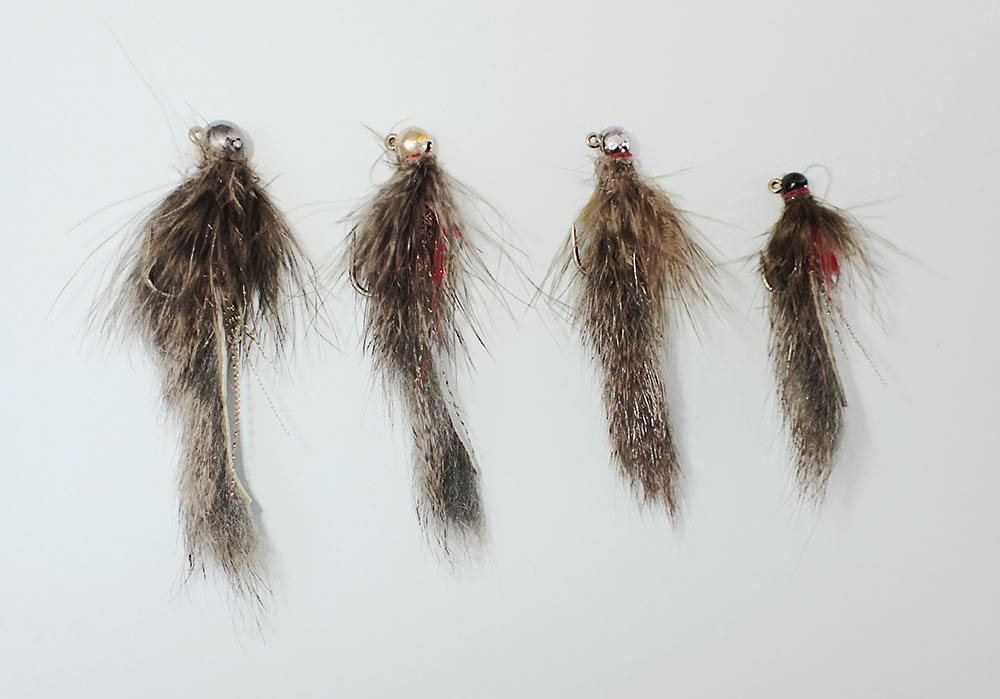 |
The jig bully
The jig bully is usually tied with 4mm, 4.5mm and 5.5mm black or gunmetal tungsten beads on #12, #10 and #8 TMC 413 jig hooks, respectively.
I probably use the 4.5 mm bead option most, but switch to the 5.5 mm streamer when I need more depth or the water is discoloured. In fact, I seem to be using the 5.5 mm version more often of late. The little #12 comes in handy in slow water, including backwater.
I also have some #8 olive Jig Bullies with gold 4.5 mm beads in my box. I use these when I need a larger more visible fly, and the 5.5mm bead is too heavy - when large fish are about and/or the water has a lot of colour.
I like Jig Bullies because they look and swim just like real bullies and torrent fish, and they’ve taken a lot of very good trout. That said, your favourite woolly bugger tied on a jig hook with a tungsten bead should also do the job.
The euro approach to fishing streamers requires heavier flies as the angler needs to remain in contact with the streamers at all times to detect subtle takes. For water deeper than two or three feet, suitable flies would be sparsely tied with 5.5 mm tungsten beads. However, most of my fish are caught at distance on the drop, on the swing or when stripping, so lighter flies, with 4-4.5mm tungsten beads, also work very well.
 |
This big brown trout was caught on a rising river with a Jig Bully in less than 1 foot of visibility
When and where do streamers work best
When fish are chasing streamers it’s hard to imagine a day when streamers fail. Unfortunately there are days when fish chase the streamer with great excitement, but refuse to take.
Understanding the seasons and conditions when streamers work best helps to narrow the odds.Also, resident trout in some rivers are more susceptible to streamers than trout in other rivers. Less invertebrate prey, the presence of baitfish and higher densities of trout all seem to play a role in increasing streamer appeal.
Winter:
Streamers can work really well in winter. Although trout are less active at lower water temperatures, there’s less insect activity in winter and the chance of some easy calories is probably what gets them going.
Winter is also the time when the slow jigging euro approach or a slow swing is often best. Although it pays to experiment with faster retrieves as well.
Spring and early summer:
Spring is the time to fish jig streamers for sea trout in the lower reaches and estuaries of many New Zealand rivers. Whitebait and smelt enter rivers at this time of year and bullies move downstream to spawn where sea trout and resident fish feed avidly on them.
Bullies are well imitated by a jig streamer. Jig streamers tend to work well in tidal reaches and nearby pools at this time of year. On rivers where resident trout feed largely on insects, jig steamers tend to lose their appeal further upstream, especially if the water is clear.
Autumn:
Brown and rainbow trout become more aggressive in autumn as they begin packing on condition for the spawning season. This is also the time of year when torrent fish are most abundant in braided rivers and move to the lower reaches to spawn. Autumn is a good time of year to fish streamers.
Time of day: Predatory, fish-eating, trout are most active when light levels are low. The best time to fish streamers on sunny days when the water is clear is before the sun touches the water or once it has moved away. On overcast or rainy conditions, fishing is often good throughout the day.
After a ‘fresh’: Streamers are particularly effective when river levels are dropping after a ‘fresh’ and the water has some colour. This is also when sea trout tend to enter rivers from the sea.
Larger insects are dislodged and swept downstream during a high flow, so #12 and #10 olive jig streamers are frequently taken to be ‘creepers’ (Dobson fly larvae) when cast upstream and fished on a tight line - based on the stomach contents of fish I’ve killed.
When river levels are especially high and water is dirty the fish often hold in slower water against the banks, so fish the river margins before wading in. Fortunately one doesn’t need much visibility for a jig streamer to prove successful.
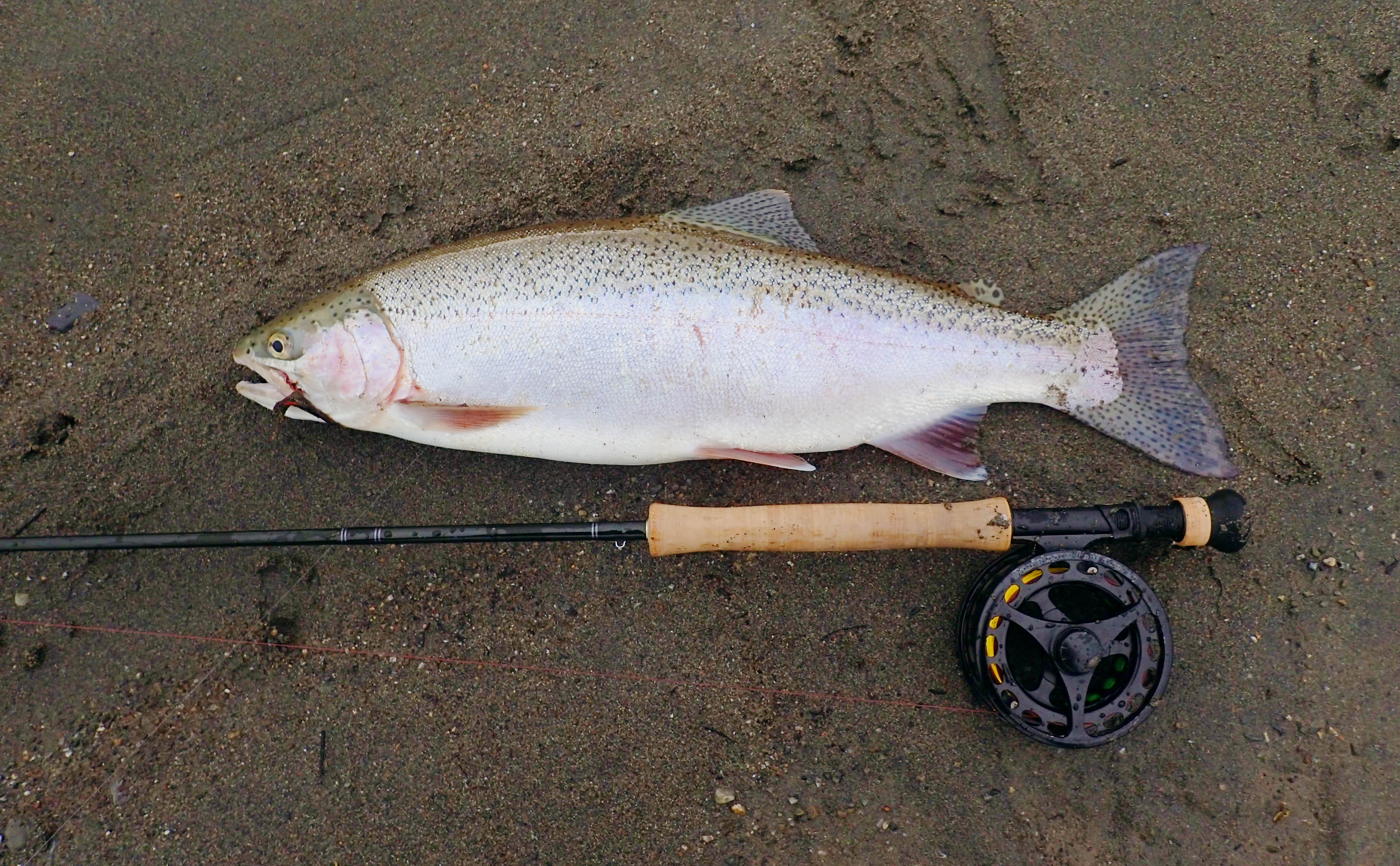 |
One of several sea run rainbow trout I have caught on a jig streamer
Best rods for jig streamers
One can easily fish jig streamers on mono rigs with a standard 9 ft 5wt rod. Because you need the weight of the streamer to load the rod, a medium fast rod with progressive action works best - my Sky G 5wt has proven to be an excellent choice.
A longer rod achieves a bit more distance and helps keep streamers above bank side vegetation when casting. Longer rods also provide slightly better control and animation of the streamer during presentation, especially at longer distances. However, specialised longer rods are not as beneficial as they are for euro nymphing.
My favourite jig streamer rods are a deeper flexing, but crisp fast action 9.5 ft 5wt Sage X and a 10 ft 4wt Sky G euro rod.
The 10 ft 4wt is great for 3.5, 4.5 and 5.5mm tungsten bead streamers. The 9.5 ft 5wt casts very well with both 4.5 mm and 5.5 mm beads.
While I need an extra false cast with the lighter bead, the additional power of the 5wt gives me a few extra meters with the 5.5 mm bead streamer. Being stiffer, the 5wt is also better at setting at distance the heavier gauge #8 TMC 413 J hooks I favour for large New Zealand trout, and is better in strong wind.
A 9.5 ft 5wt has a lower swing weight than a 10 ft 5wt, and because I make two or three crisp false casts during each cast, the swing weight starts to matter when casting all day with a 5wt rod. The 10 ft 4wt has an extremely light swing weight, so no issues there.
Choice of rod depends on the conditions
I tend to use the 9.5 ft 5wt for larger rivers if I’m expecting to fish jig streamers most of the day, and the 4wt for smaller water.
If it’s sunny and the river’s low and clear, I may go with a 9 ft 5wt Sky G because, apart from the first hour or two, I’m likely to spend most of my time casting to visible fish with a floating line, when accuracy and presentation are key to success.
If the forecast is partly cloudy with showers in the morning, clearing to fine in the afternoon, and the water’s clear enough to spot fish, then the 10 ft 4wt or the 9.5 ft 5wt are both good with jig streamers and a 5wt double taper line. I choose the 5wt if I am expecting wind.
The distance from the cork grip to the stripping guide can make a difference when fishing mono rigs.
On the 5wt Sage X this distance is 19 inches and on the 4wt Douglas it is 13.5 inches.
When stripping streamers on the 5wt Sage X, I occasionally lose the 20 lb Maxima from between the thumb and index finger of my rod hand but this rarely occurs with the 4wt rod. On euro rods the first guide is much lower along the blank to prevent lines sagging, which helps when stripping flies with thinner mono.
A note on reels
A full cage reel is recommended for mono rigs as it prevents thin lines from squeezing between the spool and the frame - known as pull-through.
I like reels that spin easily when I slap the palming ring or flick the handle, as they enable me to quickly recover thin mono lines when hooking a fish. Particularly important when making long casts and stripping streamers, as loose line shooting up when a good fish makes a dash has a habit of tangling on gear, resulting in disaster.
My reel of choice for jig streamers on mono rigs is a Danielsson F3W 4seven, for which I have two spools.
On one spool I have 100 m of backing and 30 yards of 25 lb SA Flat Mono running line, to which I attach a 60 ft 20 lb Chameleon/Sufix Superior mono rig using a loop-to-loop connection. When I want to use a Skagit or Scandi head for an extended period, I wind the mono rig onto an empty spool I carry in my bag, and attach the shooting head.
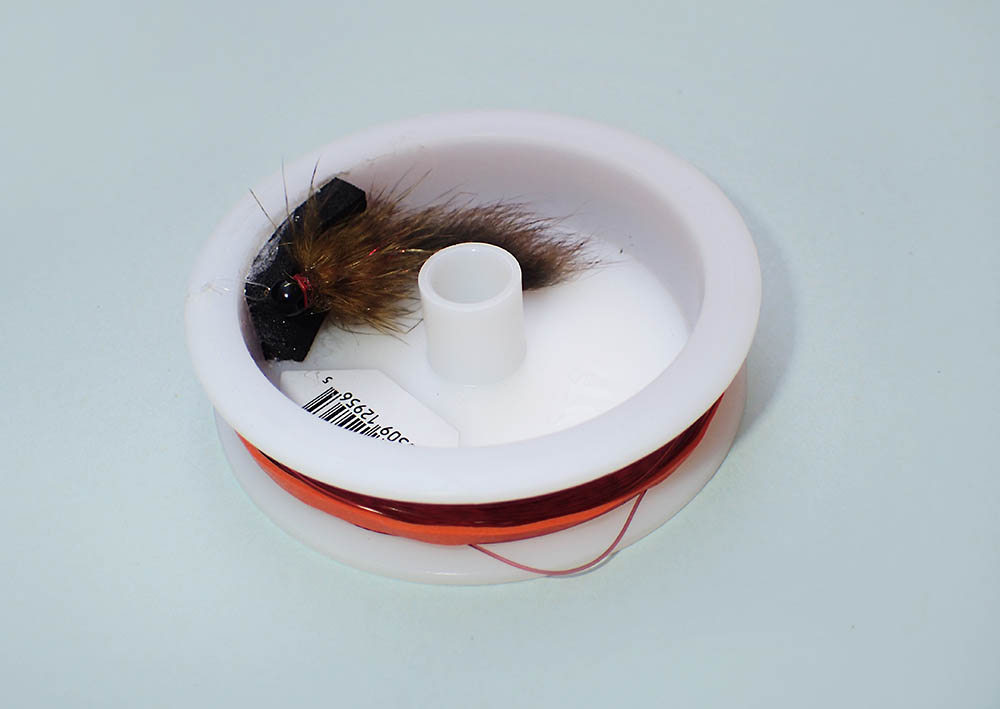 |
Rig winder for 60 foot Maxima Chameleon mono rig made from an empty SA Flat Mono shooting line spool
Note the piece of foam glued in for the streamer, the slot cut into the side of the spool to take the tippet. The flange on these spools provides something to hold when winding on the rig. If there is no streamer attached the tippet ring can be held in place using the slot.
If I am spey casting and want to try a quick few flicks with a mono rig in water I can’t effectively fish with Spey gear, I may loop a short Chameleon leader - that I keep stored in my my tip wallet - onto the running line, which then becomes a mono rig.
The leader consists of 2-3 ft of 20 lb and 1.5 ft of 12 lb Maxima Chameleon, with a loop on the butt end and a large tippet ring attached to the 12 lb.
Alternatively, if switching frequently between Spey Casting and mono rigs, one could replace the SA Flat mono with 20 lb Sufix Superior Neon Fire or Amnesia and use this as a mono rig for jig streamers and a running line for shooting heads. Choose the option that maximises efficiency and fishing time.
If one is not interested in casting spey gear on a single hand rod, then simply remove the tapered leader from a floating line and attach the mono rig directly to it. Swopping it back when the floating line is needed.
I find switching spools quicker and more convenient than transferring a 60 ft mono rig back and forth.
Since I switch more often between jig streamers and floating lines, than I switch between jig streamers and heads for Spey Casting, the second spool for my Danielsson F3W 4seven is loaded with a 5wt double taper floating line. I use the floating line for indicator nymphing or targeting sighted fish with a dry dropper or small indicator.
I usually only switch to Spey gear on my local rivers when I want to fish soft hackles during a hatch or small white bait patterns near the surface, but each fishery is different.
Conclusion
Fishing jig streamers on mono rigs is a fun, versatile and a highly effective approach for New Zealand Trout.
The tight-line mono-rig streamer techniques featured in numerous videos by high profile North American anglers do work well in New Zealand in certain fishing situations. I have, however, found that casting significantly further and stripping and swinging jig streamers is an effective way of covering large areas of water without spooking fish.
The main reason I fish streamers on mono rigs as much as I do, is because they work so well when conditions are not good for spotting, e.g. when the river is high or coloured up or it’s overcast or raining - particularly relevant for New Zealand rivers with low amounts of fish. I have learned the hard way that fishing streamers on regular fly lines or on Spey gear is not nearly as effective in these situations.
The other reason I like streamers on mono rigs is that this system is highly effective for sea trout, even when skies and water are clear.
I like using this system early in the morning in the lower reaches, for sea runners and resident fish onto baitfish. When the sun is high enough I switch to a floating line, working my way upstream with a dry dropper, spotting fish. All with a single 4 or 5wt rod. No-one wants to be carrying two rods when covering large distances to find fish.
 |
Sea trout love jig streamers
If you enjoy fly casting and the thrill of aggressive fish hitting streamers, then I encourage you to give jig streamers on mono rigs a go.
A presentation 9 ft 5wt rod is a good place to start. All you then need is 50 ft of 20 lb Maxima Chameleon, Sufix Superior Neon Fire or Amnesia, which can be looped onto the front of your regular floating line, and a few jig streamers of suitable size. Casts of around 45 ft are easily achievable with a 9 ft rod.
Although casting jig streamers on mono rigs is similar to regular overhead fly casting, it requires some adjustments that take a little practice to master. Whatever you do, don’t give up too soon, practice really does make perfect.
< End >
Thanks to Domenick Swentosky, George Daniel and Joe Rotter for their articles and videos on jig streamers on mono rigs, which started me on this rewarding journey.
Useful links
To buy Maxima Chameleon and Maxima HV in New Zealand :
https://www.flyshop.co.nz/product/maxima_chameleon.html?srsltid=AfmBOopMLeACChzs6e4xcU9WKX-U4ywG9EDCBJ6RM19fiyRP5429TPgo
More on making and fishing mono rigs
Nobody has written more on the topic of mono rigs than Domenick Swentosky, and this article is great background for anyone considering this approach.
There are some differences between my mono rig system and the one Dominick uses for streamers.
As I do more casting and stripping/swinging and less euro style streamer fishing or nymphing, my section of 20 lb Chameleon or Sufix Superior is much longer than his, and my sighter and taper are simplified to provide more turnover power at distance.
https://troutbitten.com/2021/03/14/design-and-function-of-the-troutbitten-standard-mono-rig/
Backing Barrel sighters
A great video on how to construct a backing barrel.
https://troutbitten.com/2021/10/08/the-backing-barrel-might-be-the-best-sighter-ever/
Sufix Neon Fire for Mono Rigs
In this article Domenick Swentosky explains why Sufix Neon Fire is his favourite line for a high visibility mono rig.
Note that the Amnesia Domenick discusses in his article is dismissed because it is oval in cross section. The Amnesia I tested is round.
https://troutbitten.com/2024/02/15/hi-vis-leader-material-for-mono-rigs/
Best fly rods for the mono rig
Domenick Swentosky favours a 9 ft 5wt fly rod for fishing streamers on mono rigs.
However, if you watch his excellent instructional videos you will note that he is usually fishing fairly small rivers and his casts are not as far as I as the ones I use on larger rivers. Shorter casts also favour the effective animation/presentation techniques he likes to use.
For the rivers and techniques that I most often fish, a 9.5 ft 5wt has a slight edge. You would, nevertheless, do very well starting off with a 9 ft 5wt.
https://troutbitten.com/2024/12/31/the-best-fly-rods-for-the-mono-rig-tight-line-and-euro-nymphing-my-favorite-rods/
See other reviews :
